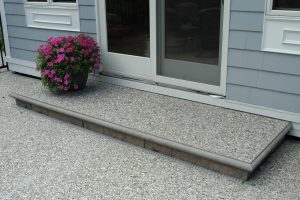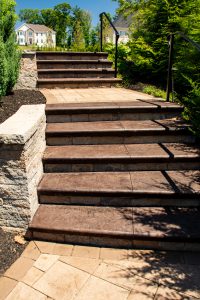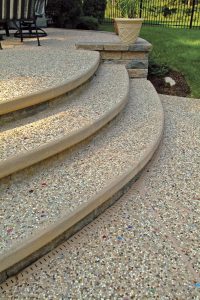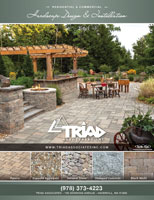
When you start planning your new hardscape, you likely think about big picture items like patios and walkways. However, the smaller, connecting pieces are where your hardscape really pulls together into a gorgeous, cohesive design. Without the right connecting elements, your hardscape can look disjointed and amateurish, and it won’t give you the functionality you need.
Steps are one of the key elements that pull your hardscape together, whether you have a simple patio leading off the back of your house or you have a more complex design that pulls together multiple items, like a pool deck, retaining wall, patio, and walkways. The kind of steps you choose can pull the design together and give you the right transitions between elements.
While you have many options for steps, depending on the design you want and the needs of the space, we often recommend poured steps at Triad Associates. Poured steps offer many benefits and give you a lot of design options, making them suitable for just about any hardscaping project.
Benefits of Using Poured Steps
Just like their name suggests, poured steps are installed by pouring concrete into a form. The steps can be poured on site, or they can be poured and cast off site and then installed in your space. In contrast, other steps are created by pouring a footing and then putting blocks and treads in place.
 Because of the way they are created, poured steps offer a great deal of flexibility in their design and installation. They can be created in any shape, and they can be installed in any location. They are ideal for unique spaces, such as oddly shaped decks and patios or small areas. They can take the shape of any form that is built for them, removing the need to cut through large, hard blocks. The installation is easier, and it offers more possibilities.
Because of the way they are created, poured steps offer a great deal of flexibility in their design and installation. They can be created in any shape, and they can be installed in any location. They are ideal for unique spaces, such as oddly shaped decks and patios or small areas. They can take the shape of any form that is built for them, removing the need to cut through large, hard blocks. The installation is easier, and it offers more possibilities.
Poured steps are also durable. They are typically made of one piece, which means that there are fewer opportunities for the steps to separate or move. Even poured steps that have more than one piece are more durable than steps that are composed of individual blocks.
Finally, poured steps offer a greater range of design options since they can be stamped, colored, and more. You can get just about any look you want, often for a lower price.
Design Options
The designers at Triad Associates work closely with clients to determine the perfect design to meet the needs of the space and to bring your vision to life. One of the benefits of using poured steps is that they are flexible in their design options. Here are some of the many options that are clients choose from to create gorgeous hardscapes:

Aggregate on top. Aggregate can be added to the tread of each step to create an interesting design, with different colors and textures. The color can contrast the risers, or it can complement it. The texture also enhances the safety of the stairs, reducing the risk of slipping.
Stamped and stained concrete. Other colors and textures can be achieved by stamping or staining the concrete, both on the treads and the risers. The same design can be stamped on all aspects of the stairs, or contrasting designs can be used on different parts of the stairs.
Contrasting borders. Often, the steps are placed at the edge of another hardscaping item, such as a pool deck or patio. A contrasting color or stamp can
be used to turn the steps into a kind of border for the space. Coping can also be used on the border to create a nicer, finished edge.
Veneer on the front. Poured steps are durable and flexible, but they don’t have to be limited to the concrete itself. Veneer can be added to the front of the steps, the risers, to provide more design options. Veneer is available in a wide variety of options to mimic many different types of stone.
One step or more. Steps don’t always have to include multiple steps. Sometimes, you just need one large step to provide a transition between different levels of patio, or from one hardscape segment to the next, such as from a patio to a pool deck. Consider how elegant and impact the right step can be.
Placement of Poured Steps

There are a lot of ways that you can use poured steps in your hardscaping. The designers at Triad Associates will work closely with you to determine where you can best incorporate poured steps to enhance the look and functionality of the space.
One of the most common places to install poured steps is the area in front of a door. Sometimes, these steps are functional, as they provide the needed incline to get to a raised door. Other times, t
he steps provide a transition between the house and the hardscape. Either way, the choices you make for the steps will have a big impact on the kind of entryway you have for your home.
Steps are also commonly placed as transitions between patios or between a patio and a pool deck. They not only provide a functional element, but they create a transition in the design.
Steps can be installed as a pathway through a yard, creating a safe, walkable area. They can connect areas, like the driveway to the entryway, or they can provide a pathway through the landscape.
Finally, steps can also be placed between retaining walls, providing easy access between one tier of the landscape and another.
Work with the Expert Designers at Triad Associates to Create Your Dream Hardscape
The hardscape designers at Triad Associates have been creating beautiful spaces for Haverhill residents for more than 40 years. Let us help you transform your outdoor living space to make a beautiful oasis where you’ll love spending time. Whether you just need to add some poured steps to an existing space or you’re ready to design the whole area from scratch, we’re ready to help you. Call us today to schedule a consultation and start exploring the possibilities for your property!




